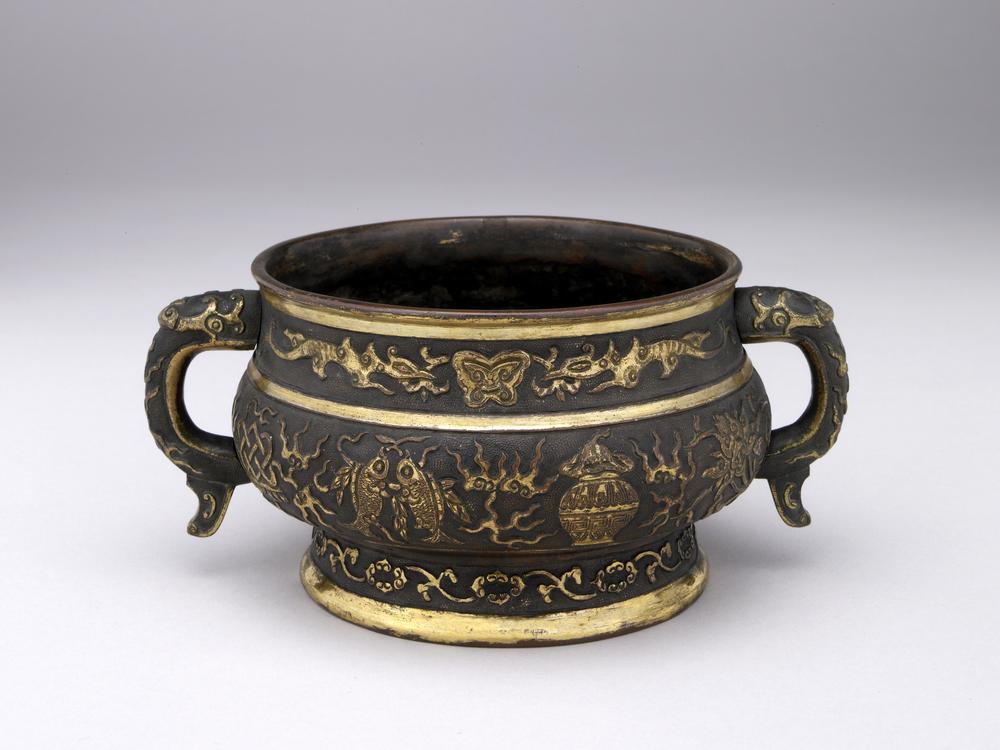Period:Unknown Production date:2008
Materials:paper
Technique:
Dimensions:Height: 180 centimetres Width: 35 centimetres
Description:
Painting, trees, an empty pavilion and a bridge with a figure crossing it, burnt into xuan paper, overlaying calligraphy in ink on a second sheet of xuan paper. Chinese ink and burn marks on xuan paper.
IMG
![图片[1]-painting; calligraphy BM-2012-3001.1.a-China Archive](https://chinaarchive.net/Unknown/Paintings/mid_RFC43545_1.jpg)
Comments:Each pair of works consists of a standard size vertically orientated work and a miniature size work. All four works consist of two layers of paper each –the top layers carry imagery and words created by burn marks and these layers are superimposed on top of another paper layer that carries painting and calligraphy rendered in ink alone. Digital-No.08-MH70 features trees, an empty pavilion and a bridge with a figure crossing it. Semi-cursive calligraphy rendered by burn marks appears on the left side slightly below mid-level of the top sheet; ink characters, written in semi-cursive script, appear on the left near the top and appear through a “haze” since they are actually written on the “under sheet” and show through the translucent top sheet. Wang Tiande embarked upon his ongoing Digital series in 2002, using a cigarette to burn images into silk or paper; after 2005 he substituted incense sticks for cigarettes. The landscapes from this series both play on and represent the distance between contemporary conceptual art and traditional Chinese ink painting. Combining two works of art to create a third, Wang paints a landscape in the traditional mode using ink and brush on paper, and burns a second landscape into semi-transparent paper. That Wang is a talented calligrapher and ink painter is revealed not only in the ink landscape, but also in manner in which he wields the incense stick, turning and tapering strokes as dictated by traditional precepts of calligraphy and painting. When painted and burned landscapes are layered together, a complex third image is revealed, compelling but defying attempts at resolution. Symbolically viewing the past through the present, we cannot obtain a clear understanding, but instead find a new meaning relevant to our times. The obfuscation can be compared to efforts to understand art of the past through digital reproduction. Wang creates pairs of similar large and small (“father and daughter”) landscapes to suggest that even when the full grandeur of the original is not present, with close consideration we nevertheless can catch its essence from its figurative descendent.
Materials:paper
Technique:
Dimensions:Height: 180 centimetres Width: 35 centimetres
Description:
Painting, trees, an empty pavilion and a bridge with a figure crossing it, burnt into xuan paper, overlaying calligraphy in ink on a second sheet of xuan paper. Chinese ink and burn marks on xuan paper.
IMG
![图片[1]-painting; calligraphy BM-2012-3001.1.a-China Archive](https://chinaarchive.net/Unknown/Paintings/mid_RFC43545_1.jpg)
Comments:Each pair of works consists of a standard size vertically orientated work and a miniature size work. All four works consist of two layers of paper each –the top layers carry imagery and words created by burn marks and these layers are superimposed on top of another paper layer that carries painting and calligraphy rendered in ink alone. Digital-No.08-MH70 features trees, an empty pavilion and a bridge with a figure crossing it. Semi-cursive calligraphy rendered by burn marks appears on the left side slightly below mid-level of the top sheet; ink characters, written in semi-cursive script, appear on the left near the top and appear through a “haze” since they are actually written on the “under sheet” and show through the translucent top sheet. Wang Tiande embarked upon his ongoing Digital series in 2002, using a cigarette to burn images into silk or paper; after 2005 he substituted incense sticks for cigarettes. The landscapes from this series both play on and represent the distance between contemporary conceptual art and traditional Chinese ink painting. Combining two works of art to create a third, Wang paints a landscape in the traditional mode using ink and brush on paper, and burns a second landscape into semi-transparent paper. That Wang is a talented calligrapher and ink painter is revealed not only in the ink landscape, but also in manner in which he wields the incense stick, turning and tapering strokes as dictated by traditional precepts of calligraphy and painting. When painted and burned landscapes are layered together, a complex third image is revealed, compelling but defying attempts at resolution. Symbolically viewing the past through the present, we cannot obtain a clear understanding, but instead find a new meaning relevant to our times. The obfuscation can be compared to efforts to understand art of the past through digital reproduction. Wang creates pairs of similar large and small (“father and daughter”) landscapes to suggest that even when the full grandeur of the original is not present, with close consideration we nevertheless can catch its essence from its figurative descendent.
© Copyright
The copyright of the article belongs to the author, please keep the original link for reprinting.
THE END
![[Qing Dynasty] British female painter—Elizabeth Keith, using woodblock prints to record China from the late Qing Dynasty to the early Republic of China—1915-China Archive](https://chinaarchive.net/wp-content/uploads/2022/11/image-191x300.png)




